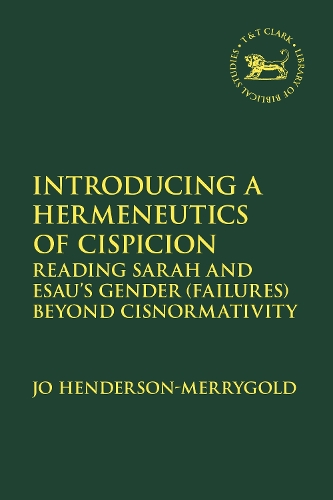
Introducing a Hermeneutics of Cispicion: Reading Sarah and Esaus Gender (Failures) Beyond Cisnormativity
(Hardback)
Available Formats
Publishing Details
Introducing a Hermeneutics of Cispicion: Reading Sarah and Esaus Gender (Failures) Beyond Cisnormativity
By (Author) Dr Jo Henderson-Merrygold
Bloomsbury Publishing PLC
T.& T.Clark Ltd
11th July 2024
United Kingdom
Classifications
Professional and Scholarly
Non Fiction
Religious aspects of sexuality, gender and relationships
Gender studies: trans, transgender people and gender variance
220.601
Physical Properties
Hardback
240
Width 162mm, Height 236mm, Spine 20mm
520g
Description
A hermeneutics of cispicion challenges cisnormative presuppositions that shape and, at times, occlude the variations in gender and sex exhibited by key characters in the ancestral narrative of Genesis 1250. It charts the progression from Paul Ricoeurs hermeneutics of suspicion, through liberation, feminist and queer approaches. Focusing on Deryn Guests queer and trans hermeneutics, Henderson-Merrygold then offers a new strategy for reading against fixed, binary gender assumptions, where a characters sex always matches that assigned at birth. The initial case study addresses Sarah, who is the proto-matriarch of the ancestral narratives in Genesis. Masculinities contrast with femininities, and Sarahs own agency makes the picture of a consistent gender hard to identify. By closely reading the text, different facets of Sarahs story emerge to emphasise how much the narrative directs the reader towards a cisnormative reading. However, Henderson-Merrygold shows it is not only the images of Sarah as feminine woman and mother that remain visible. The subject of the second case study, Esau, is regularly judged to be a hypermasculine character due to his bodily appearance, but repeatedly fails to fulfil the expectations related to that appearance. Though often condemned as a poor example of (hyper)masculinity, a cispicious reading identifies a richer and more nuanced figure. Attending to Esaus actions, his rejection of the gendered expectations appears intentional, allowing him to settle more comfortably into his own identity. This project advocates for, and demonstrates the value of, creative, interpretations of biblical texts that challenge both malestream and feminist gender assumptions.
Author Bio
Jo Henderson-Merrygold is Director of the Centre for Discipleship and Theology and The Queen's Foundation, Birmingham, UK.
